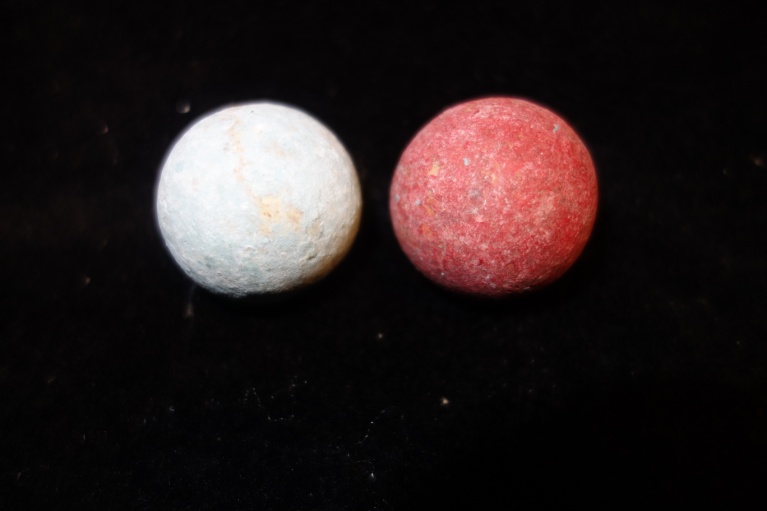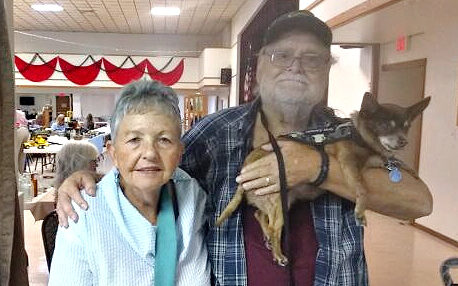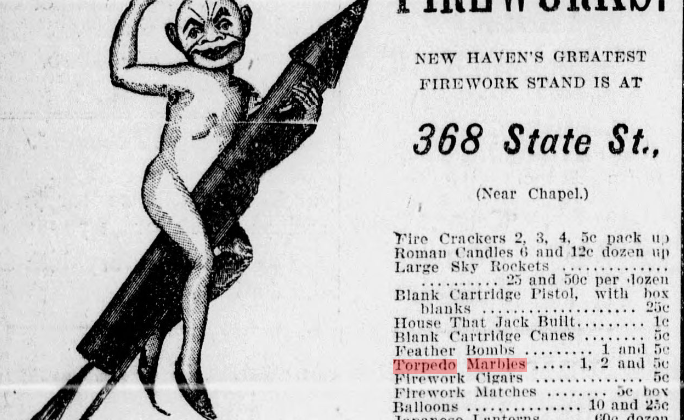
New Haven, Connecticut The Daily Morning Journal and Courier July 1, 1901[1]
They Put What on a marble?
This is the same heading we used to start our story Marshmallow Marbles? In that post we explained how incredulous we were to learn that a company made and sold marshmallow candy. It was unbelievable to us that any company would make and market candy with marshmallow entirely covering a glass marble.
Well, we found something even more unnerving! Between about 1900 – 1915 marbles were sold in America which were coated in a deadly poison! Marbles were turned into powerful poisonous impact pyrotechnics! Imagine the possible outcomes of a heated game of marbles. But then “In order to attain the impossible, one must attempt the absurd.” – Miguel de Cervantes Saavedra.
What Were They?
The best description of a repeating torpedo marble which is from the trade journal The American Stationer . It was published weekly on newsprint from 1873 until at least 1928 for the New York stationery and fancy goods trade..[2]
“Repeating Marbles This well-known toy, formerly called the Repeating Torpedo, or Torpedo Marble, has been greatly improved recently. It is free from poisonous substances, and is much more sensitive than formerly. It consists of an ordinary playing marble coated with a compound which when struck against a stone pavement or other hard substance, or when two of them are struck together makes a loud report, similar to a firecracker or pistol cartridge [c. 1900 Cast Iron cap gun pistol??]. Each marble will produce from 50 to 100 or more reports, and when the coating is worn off can be used as an ordinary marble. They are absolutely safe to carry in stock. They will not explode, except at the point struck by a hard body, and are not inflammable. This is one of the best selling toys that have placed on the market in recent years….”
Free from poison? 50 – 100 “bangs” per marble? Safe for stores to handle, store, and offer for sale? What could possibly go wrong?
The Marbles were Probably Clay
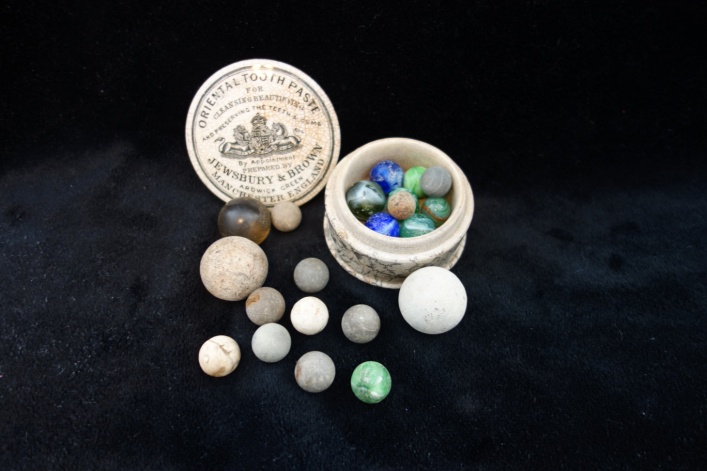
We can only imagine, but cannot be certain, that these impact marbles were made of clay. This idea is reinforced by the advertisement which is the lead image for this post. In New Haven, Connecticut, in 1901, the same year as the The American Stationer’s report was published, these repeating marbles were sold for from a penny to a nickel each.[3]
Glass marbles would have cost more and while we have no idea what the explosive composition was on the surface of the marbles, it would probably adhere much better to clay than to glass.[4]
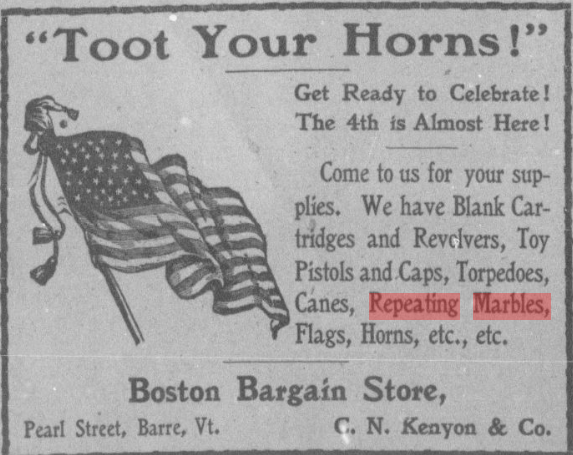 Barre, Vermont, The Barre Daily Times, July 1, 1903[5]
Barre, Vermont, The Barre Daily Times, July 1, 1903[5]
Torpedo Marbles?
In the late 1800s and into the early 20th century the word torpedo was applied to just about any substance and device that was manufactured to explode. John Donner in Impact Firecrackers tells us that “…reliable information about the early history of torpedoes is scarce.” (page 2).[6]
Now that we have introduced explosive, loud, and dangerous torpedoes as toys, and the application of pyrotechnics and poison to toy marbles, which on each impact repeated a loud bang from 50 – 100 times, let’s jump forward some 80 – 90 years and see how it all ended with a whimper.
Fast Forward
While the name sounds ominous, these more modern “hand blasters” are an example of what Donner calls mere shadows of their former selves (page 1).
There is no poison here; no pyrotechnics; and it is hard to see how anyone could get hurt playing with them.
We bought these in an antique store in Vienna, West Virginia, in September 2022. The two balls, at 1⅜”, are too big to be playing marbles. It would also be hard to get one in your mouth! One is red and one is light blue-green. We simply had no idea in the world what these things are. One wild guess in the shop was skittle balls.
However, as Joanne continued looking at these things in the store, another customer showed her how they work. Strike them together and sparks fly! We were astounded to learn that they are “Blaster” balls. Their only purpose is to watch the sparks and hear the “pop”.
Everyone gets to keep their teeth and hair! Evidently, these were very popular in the 1980s – 1990s, but somehow we totally missed the trend and we had never heard about them.
What Are These?
“Hand Blasters are ceramic balls that are coated with a variation of the same materials used to make caps for [modern] cap guns. A thin layer of potassium chlorate, sulfur, glue and powdered glass (silica) covers each Hand Blaster. When the coated surfaces of the two balls collide, a blast [and spark] is produced at the point of impact.”[7]
What Could Possibly go Wrong?
Well, a number of exciting things, actually. Remember, we read in The American Stationer (1901) that repeating marbles were free from any poisonous substances and that they were safe for merchants to stock and to store. And when the pyrotechnics had worn off the child had a perfectly good toy marble.
Donner provides a wealth of detailed and complex chemistry about many types of toy pyrotechnics, but he does not discuss torpedo repeating marbles specifically.
So we still cannot be 100% certain exactly what coated the marbles. We believe that they were coated with something very similar to the later “cracker balls” which were about the size of a pea.
Great Balls of Fire!
These cracker blaster balls used an explosive mixture of potassium chlorate and arsenic disulfide[8]. Yes, if a kid put one of these in her or his mouth then he or she could have been poisoned and/or had their teeth blown out!
Donner (pages 22-23) tells us that in making reproduction cracker balls he uses as much as 33% Arsenic disulfide and 67% Potassium chlorate. “When dry this composition is very, very sensitive to shock, friction, and heat!”
The Search for Patents
Charles Nelson patented (#65,764) clay torpedoes in 1867 and Donner (page 1) notes that over the years individuals have patented many different types of torpedoes. However, we have found such patents extremely hard to find. But remember, the patents illustrate how to use explosive, corrosive, and poisonous pyrotechnics.
And we cannot even find the exact name of any fireworks company which made and distributed the repeating torpedo marbles.
If anyone reading this knows a solid company name and patent information regarding these impact torpedo repeating marbles then please contact us and we will share the new information with everyone.
Bomjak?
One name we have seen associated with marble torpedoes is Bomjak or Bom Jack. This is from a 1903 Fireworks Catelog: “BOMJAK MARBLES. Are one of the best 4th of July novelties. Harmless. No accidents can occur with them. By striking two together, or throwing them against a hard surface a loud report is made. 4 in a box. Per gro 90”[9]
In June 1902 The San Francisco Call advertised four Bomjak torpedo marbles for 5¢. This same year the Call printed an ad for Will and Finck Company for Bomjack repeating marbles four for a nickel. And In this Will and Finck ad there is another item of interest: Star Mines are also listed.
Finally, A Clue To Torpedo Marbles
The two names Star and Bomjak linked together did give us a clue.[10] Still, we cannot say with absolute certainty that Star Fireworks was the maker of the torpedo repeating marbles which we have been discussing.
On the other hand, the timeline is correct. There were multiple listings for Bomjak torpedoes in the San Francisco area at the time, and Star was a Fireworks merchant if not a maker, and finally, exactly how many different “Bomjaks” could there have been at the time? But we cannot find a patent for torpedo marbles filed by Star Fireworks.
“My Hair’s on Fire!”
“In the early 20th century, the Fourth of July was often a dangerous holiday. In 1903 alone, according to the Journal of the American Medical Association, 466 people died and 4,449 people were injured from holiday-related accidents. …From 1903 to 1909, a full two-thirds of July 4th deaths connected to explosive incidents were tetanus deaths.”[11] The press at the time reported tetanus as lockjaw. There were more causalities in some locations on any 4th of July than there were at the Battle of Breed’s and Bunker Hills.
In 1907 the Salem, Ohio, News reported that over the 4th of July “Paul Albright, son of J.E. Albright of Limaville, dropped a sack of torpedo marbles and was badly burned about the arms and his hair singed in the explosion that followed.”
The same story, “Belated News about ‘Fourth’ Casualties”, published two days after the holiday and with the tally still rising, reported 37 dead and 2,153 hurt statewide. Monetary loss was $340,555 which is about $10,899,200 in 2023 valuation![12]
A Safer Celebration
We’ve mentioned that these deadly torpedoes were much more powerful than today’s fireworks. Police Chief Dolan, of Wilmington, Delaware, was planning for the 4th in 1900. He had this to say:
“Young Americans Will be Allowed to Celebrate the Fourth…, but [I] will not allow dynamite torpedoes and torpedo marbles to be sold….The only damper this [Police Department] will put on the celebration is on that part of it that leads young men to explode what we call dynamite torpedoes.
A chemical analysis has showed us that the ingredients of this particular kind of torpedo form an explosive six times as strong as powder. …We have ordered dealers throughout this city to stop selling it. We also have prohibited the sale of the torpedo marble, not because it is dangerous to limb, but because it is a poison which, if taken into the body of a child, would kill it in a few hours.”[13]
Slingshot
Contrary to The American Stationer and to so many others advertising impact pyrotechnics at the time, repeating torpedo marbles were not safe. At any speed. They exploded at inopportune times like while in a pocket or sack; and they were deadly poison. Children could and did get the explosive substance, whatever it was, on their hands and clothes and directly into their mouths.
Lots of kids grew up hunting rabbits, squirrels, and doves with a stone or even glass marbles in a slingshot. Glass is light weight ammo but it does work. And, kids have always hunted each other with marbles in a slingshot! We haven’t seen any casualties in the archival press who were reported as hurt with a repeating marble fired with a slingshot, but we can only imagine that someone did try it. The image that comes to mind is tragic!
The Last Long Goodbye
Americans love their fireworks and the 4th of July remains a perennial favorite for firework shows. In 2021 alone we spent over $2.4 billion on fireworks.
Still, interest in the loud, poison, and deadly dangerous impact repeating torpedo marbles had started to wane by about 1910. Police Departments had grown weary of the noise and damage and were cracking down on all impact torpedoes. Health Departments nationwide were doing a good job informing the public — and parents specifically — about the dangers of the explosive marbles. And schools were especially vigilant.
Their Final Impact
But, there’s more to it. One of the main reasons why sales of repeating torpedo marbles declined steadily year after year is that the children themselves lost interest. The novelty wore off. The message got through that they were dangerous even if they did not explode.
Impact explosives could be bought legally in many states as late as the 1950s, but not repeating marbles. And then, finally, the trend became history.
Any left anywhere?
We opened this post with a question and that’s how we will close it. Where did the leftover stock of impact repeating torpedo marbles go? We see those heavy cast iron cap pistols in antique shops from time to time and they can still be found online. Some are nearly 150 years old, and they do still fire!
Donner tells us that some of those clay torpedoes which we note in this story are still around. We have no idea whether or not they are still loaded and whether or not they would still explode.
Popping Canes
One impact pyrotechnic from the late 1800s which was very low tech was the cane. Simplistically, this is a walking cane with an explosive in the tip. When struck on a hard surface it would “pop”. There must be a lot of these in shops.
So, the final question: Are there any impact torpedo repeating marbles in shops, museums, old barns, or gramp’s closet? Have you seen one? Do you have one in your marble collection? Would the explosive compound coating the marble still explode?
If you do have one or if you have any additional information on the topic which you would share with us and our other readers then please do share!
Footnotes
- New Haven, Connecticut The Daily Morning Journal and Courier July 1, 1901 [volume], July 01, 1901, Image 7 About The daily morning journal and courier. [volume] (New Haven, Conn.) 1894-1907↑
- “Repeating Marbles.” The American Stationer, 49.3. January 19, 1901, np. ↑
- We found torpedo marbles advertised for sale for a penny each in a Doll Store in the Richmond, Virginia, Dispatch. The ad was published on December 02, 1900, Page 22, Image 22 About Richmond dispatch. [volume] (Richmond, Va.) 1884-1903 They are described as inflammable, which means they are not capable of bursting into flames without ignition.↑
- This idea comes from our study of: Donner, John. Impact Firecrackers, revised 1996. In his report of “Charles Nelson’s 1867 Clay Torpedo” Donner tells exactly how he made clay torpedos from “good quality ceramics.” Nelson does acknowledge that “other material than clay may be used.” It should be pointed out that the explosive composition was inside the clay ball and not on the surface as with torpedo marbles. ↑
- The Barre Daily Times., July 01, 1903, Image 5. About The Barre daily times. (Barre, Vt.) 1897-1959 ↑
- The word torpedo is from the Latin meaning “electric ray,” originally “numbness, sluggishness” from torpere “be numb” The sense of “explosive device used to blow up enemy ships” is first recorded 1776, as a floating mine; the self-propelled version is from c. 1900. ↑
- PDF:Flinn Scientific Chem. https://www.flinnsci.com/hand-blasters_7d7dd16f/dc91336/ 3/212023↑
- Arsenic Disulphide, As2S2 Realgar. Also, Arsenic Trisulphide, As2S3 Orpiment is used in these type explosives. “Arsenic is safe to handle of course, provided that precautions are taken to keep it out of the nose and mouth. Perhaps the name itself conjures up images of other uses to which some arsenic compounds have been placed, but it should be remembered that soluble barium, for example, is equally toxic.” Lancaster, Ronald, et.al. Fireworks Principles and Practice, 3rd Ed. NY: Chemical Publishing Co., Inc., 1998, page 96.↑
- https://pdfcoffee.com/firework-catalog-1903-pdf-free.html 3/19/2023 ↑
- Star Teleweb was founded in 1892 as Star Fireworks & Grocery Concern Amalgamated by Penelope Starr, a San Francisco saloon keeper and entrepreneur. Popular products of the time included Star Brand Medicated Cinnamon Cigarettes, Star Bomjak Marbles, Star Whistling Prismatic Whirlwinds, and soap. Penelope was a silent partner in a second Star Market founded in Berkeley in the 1920s, and the Starr Piano Company. As the company was passed down from generation to generation, the name gradually changed to suit the times: Star Telegraph, Star Telegraphone, The Great American Star Telephone & Fax Company, Star Televend, and now, Star Teleweb. The current owner, Claudia Starr, the great-granddaughter of Penelope Starr, products and services Star Teleweb provides. https://starteleweb.com/history 3/19/2023 ↑
- “The 1900s Movement to Make the Fourth of July Boring (but Safe)” Michael Waters July 2, 2019 Smithsonian Magazine. https://www.smithsonianmag.com/history/1900s-reform-movement-made-fourth-july-safe-and-sane-180972537/3/19/2023↑
- Page 1 & 5 6 Jul 1907 Issue of Salem News in Salem, Ohio https://archive.org/details/salem-news-1907-07-06/page/n4/mode/1up?view=theater2/14/2023↑
- The sun., June 27, 1900, Image 1 About The sun. (Wilmington, Del.) 1897-19?? 3/22/2023↑

